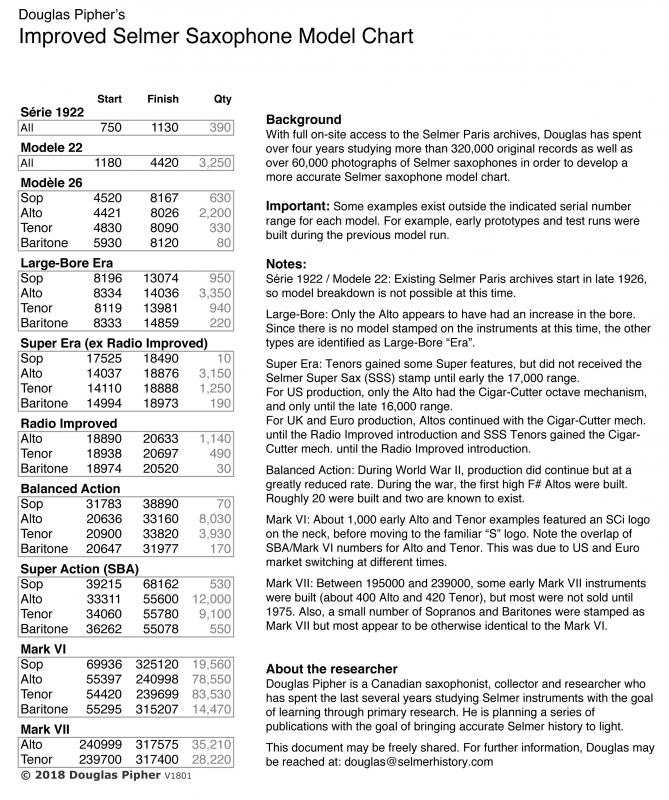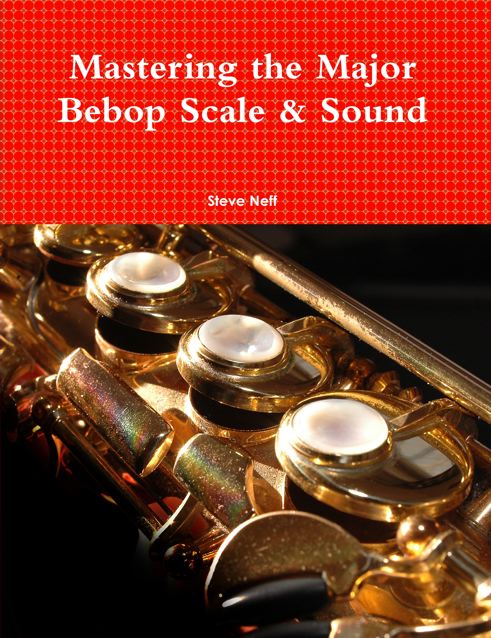Here is a cool chart of the serial numbers and models of Selmer Saxophones through the last 100 years. This chart was researched by Douglas Pipher and shared on SOTW today. The cool aspect of this chart that I have never seen before is that Douglas has included the quantities of each type of sax with each model run. I think this is so cool!
There is a serial number chart on the Selmer website which breaks the serial numbers down by year but doesn’t go into detail about the types of saxophones made nor how many. I always wondered how many Selmer Super Balanced Action (SBA) tenor saxophones there were and according to this, there were 9,100 made of which I have one. There were 83,530 Mark VI tenor saxophones made. That gives me hope that there has to be one in someone’s garage or attic up here in Vermont somewhere……..I’ll have to keep looking and stopping at those garage sales……..Thanks for the research and chart Douglas! Very interesting!
P.S. I would love to see this chart broken down by year also. Not sure if that is even possible but it would be cool to know that my sax was from 1951 and 600 tenor saxophone were made that year for example……….
Improved Selmer Saxophone Model Chart
(If you want to save the chart above, click on it so it opens in your browser. Then click on “File” and then “Save page as”)




Interesting to learn that the overlap numbers where sometimes due to the US and Europe market switching model at different time. In fact my SBA Tenor French assembled is 55xxx while there were same Transitinal Mark VI starting at 54xxx in the US.. I’m not sure if the overlap numbers between Mark vi and VII are due to the same reason..
Thanks for sharing Steve! And I’m sure there are plenty of Mark VIs in Vermont, the question is: even you find one, would you ever move from your amazing SBA to a Mark VI? I doubt it 🙂
I’ve never played a Mark VI I like better than my SBA but I am curious to try some 5 digit VIs as I have never tried one of those……..All the ones I have payed have been 6 digit.
Steve,
Thanks for the kind words.
Yes is is possible to break down this chart by year.
I plan to do exactly that in an upcoming book.
Douglas Pipher
Thanks for the hard work Douglas! Looking forward to the book!
Steve,
What’s been added/changed/improved to this list, beyond the existing legacy serial number list that Selmer has maintained and had available as the official list?
Thanks!
Scott,
It’s broken down by type of saxophone. The Selmer list just says 1951 45101-48300. That it! We don’t know how many tenors, altos, sopranos, etc….. This list gives a breakdown of how many saxes of each type were made. Steve
Is the quantity column the numbers of that model believed to still exist?
Curtis, I believe that is the number of how many were made. It would be next to impossible to research an accurate number on how many still exist………
Your site is the best, thanks so much
Very interesting! I’ve always wondered if my 34 xxx tenor were an SA or SBA. I’ve done a lot of research on the internet trying to figure out..
And there’s only two ways to do it I think.
1. Checking all existing (there’s a lot of them!)s/n-charts that different people put up and trying to find out which one you believe is the most accurate. Also, if 8/10 charts tell me the same answer that’s at least something…
2. The more funny way: Trying to learn what different features that Selmer saxes came with in that time. And when they came. More research could be published on that topic I think.
This is the first s/n chart saying, by number, that my tenor actually IS a very early SBA (and not a late BA)
I’ve found out six signs or features that came on the SBA. My sax happens to have all of them except one: “The long bell”. Selmer made the bell slightly longer sometime under the SBA era for better intonation of the low B and Bb I think. This included the single key guard over these two keys ( instead of one for each key as on my tenor and BA in general). It would be interesting to hear more on this subject. Sorry for the long comment, maybe I get into too much detail here..
Mats, My SBA is a later one at 47…. and has the two key guards on the low Bb and B keys. I’m also curious when they switched to the single. I had always assumed it was with the Mark VI but I have seen SBA’s with the single key guard for both keys also. Steve
Steve, I found a thread on SOTW saying that the single keyguard is a SBA feature to look for if you want to tell it apart from a older BA, and that it continued with the mark VI…
Interesting then that you’re sax also got two separate key guards. Meaning, I guess, that the single key guard must be a quite late feature on the SBA. Maybe with s/n somewhere round 50xxx?
Would be nice to hear a opinion from Douglas on the subject…
Taking up this thread again. I wonder when Selmer started with the ”Long Bell”? I have test played 2 different Mark VI’s, 6 digits, and when comparing to my old BA/SBA(?)-47 it`s easy to see that the bell on the VI’s are about 2-3 cm longer than on my horn. Maybe the single keyguard on low B and Bb goes together with the start of the ”Long Bell”? My reason for asking is that I always have a bit of a struggle with the low notes (my horn is newly overhauled and perfectly sealing!) especially C# and B ( C and Bb is a little better..) And unlike to you Steve, I have to say that the VI’s plays better than my horn… And I’ve even got a new neck, klangbogen and a couple of custom made heavy screws at the neckjoint wich all made an improvment on the sound. But I still think the VI’s plays better, especially on the low notes that comes out really smoothie compared to my horn.Guess I have to go to the bank and ask for a loan and make my old SBA the ”second horn”…
Mats, I’m just curious if you ever had your bow to body joint soldered? After I got my SBA my repairman did that during the overhaul. He said sometimes leaks can develop there that make the low end of the horn difficult to play…….. I don’t have any issues with the low end on my SBA and it has the double keyguard for the low B and low Bb. Steve
Aha!
No, I don’t think it’s ever been soldered..But isn’t it a bit problematic to do that? I’m thinking about future overhauls. Isn’t it much more difficult to repair it if it’s soldered? I thought it was important to be able to take the bow apart from the body and the bell? Wich I suppose is impossible if soldered? Hm.. maybe questions I should ask my repairman. But do you know if yours are a “long bell” or not? I done some research on the internet about the differences between BA and SBA. I’ve found 6 signs to look for. I won’t go into all the details about them, but my horn has 5 of them. The only one missing is the LongBell-feature. Unfortunately I don’t think it’s so easy that Selmer made the changes when they changed models…Thanks so much for the advise! I will talk to my repairman about it!
Skickat från min iPhone
I don’t know if mine is a long bow or not. Your post is the first I have heard of this. As far as soldering the bell joint my repair man, Ernie Sola, said he does it on all the Selmers he overhauls and that it is good to do so I trusted him. He has passed away now but he was a pretty knowledgable repairman and craftsmen…….. Steve
Thanks again for the soldering advice, Steve! It’s now been done! A little improvment with the low notes I think, but I still think the Mark VI have more of a full, more vibrant sound..
If anyone is interested, I have a friend who has a Mark VI tenor that he is looking to sell with serial number 55xxx. It has the “Double S” neck and matching serial number on the neck. It was his fathers and he was the original owner as far as my friend knows. He does not have the original case and it was sent back to Selmer around 1980 when it was re-lacquered and a different case was bought. It has been brought to numerous sax shops and they all said the re-lacquer job was done extremely well. All the etching is intact and looks good. He doesn’t need to sell it and his hopes are he could find a good home for it where it will actually be played and enjoyed. I know there are some discrepancies as to serial numbers and when they actually started but if what is on Selmer’s website is correct, then this would be under the 600th ever made. Pictures can be mailed upon request. My friend is aware at what the sax shops say it is worth and certainly we have looked on ebay as well so, if you would like to make an offer please be in the ballpark.
Steve, thanks for the great Selmer Chart! I will buy the book – overdue for a book to come out about the Mark 6 model changes 1954-1974 (1975)
Hi Troy,
I am interested in your 55,XXX Mark 6. Please contact me at: scottquickel@hotmail.com. Thanks man, -Scott
Just adding to this post, I have an SBA tenor serial 47,220 that has a single cage. My friend has an SBA tenor serial 47,321 with dual cages, and both horns are very original soooo it seems that the switch from dual to single cage was in that range. It’s odd that the later serial number has the dual cage but that’s the interesting and fun part of Selmer lore! I have heard stories that pro players were given special priority and early access to the best horns. Mine was owned by a famous player, so it’s possible he had early access to when they were transitioning from dual cage to single cage, but who knows. On the early SBA bell length, you can always tell a short bell because the mounting point for the B cage sits on the bell ring, and on the longer bell (later), it is mounted just above the bell ring. You can have crescents installed in the tone holes that fix the intonation problems with the shorter bell (they tend to be sharp).
Phillips, Let me get this straight, you are saying on your 47220 you have a single cage meaning one cage over both the B and Bb holes? Your friends 47321 has dual cages meaning a cage over the Bb and a separate cage over the B hole? Is that correct?
Or, are you saying your 47220 has a “single cage” meaning each cage is over one hole and your friend has a “dual cage” (the cage is over two holes)?
Steve
Interesting post Phillips! Really funny that the later S/n horn got the dual guards over B and Bb and the earlier got the single! It makes it even more mysterious when the actual shift was made.. I wonder if this keyguard thing correlated with the Longbell feature? When you have two horns side by side it’s easy to see. I now have a Mark VI65 and it’s got a significant longer bell than my old SBA-47. But I haven’t been able to compare my early SBA with a late one.. You’re also correct about that soldering point for the low B key guard: On my SBA it’s ON the bell ring and on my mark VI it’s just above. Q to Steve: where is it on you’re horn? And yes, the low B and Bb tend to be sharp on my SBA. So these crescents to mount in the tone holes? Never heard of them? What are they made of?
Mats and Phillips, My SBA is 470XX and has the dual guards. Here is a link to a photo:
http://cdn.neffmusic.com/2021/SBAKeyguard.JPG
You can see the soldering point for mine is not on the bell ring but above.
So now we know that there are SBAs with the Longbell!
Skickat från min iPhone
hi Steve! Here’s my very early SBA-47 s/n 34xxx and as you can see it has the soldering ON the bell ring! /MatsSkickat från min iPhone
Mats, Did you mean to post a photo? I don’t think you can post a photo in the comments but just a link to a photo. Steve
Yes Steve. I was trying to post a photo, but as you said it don’t work here.. Don’t now how to make a link to a photo… anyway it was just a pic of my very early SBA with the lower post of the B-keyguard soldered right ON the bell rig. So you’re horn has got the Long Bell- feature !
Hi Mats,
I’ve heard the long bell came into use around 36,XXX but not sure anyone can be certain. I have a 38,XXX horn and it has the long bell so they changed some time between 35,XXX and 38,XXX would be my guess. I believe the bells changed over time so it’s quite possible the Mark VI bell is different than say a later SBA bell. On the crescents, yes, they are pieces of brass that are fitted (glued) into the tone holes to make them smaller. This changes the pitch to make them more in tune. Les Arbuckle at Sax Oasis does them and there may be other shops but Les is great for that kind of work.
Hi Steve,
The 47,220 has a single cage that covers both holes/keys, just like a Mark VI and the later SBAs. The 47,321 horn has a single cage over the B and a single cage over the Bb like yours which is what is commonly referred to as a “dual cage” horn because there are two cages, one for each hole/key.
What’s odd is that Selmer switched from dual cages to a single cage to protect both keys, yet mine is earlier in serial number so you would expect it to have the dual cages instead of the single cage but it doesn’t and it’s very original. I know Doug would say some horns hung in the factory for a very long time before they got built, so it’s possible the serial number was stamped and when they finally got around to building it they used the single cage because they had switched by then and the serial number doesn’t really indicate when the horn was actually assembled.
Hi. I have a very old saxophone that I would like to know more about it. Almost everything in front of the bell is unreadable… has a dotted figure kind of a football shape but can not read the letters . One word seems to be professional… but not sure. the only thing is visible is LOW PITCH and 36793 at botton of low pitch engraving. could this be a SBA ?
Hello. I recently have acquired a selmer saxophone but I know nothing about saxophones. This one is in the case with some old advertisements and care tips. It is etched with fancy flowers its says Selmer with a large “U” over selmer name and a large “S” under.
It does say Elkhart Indiana with a serial number of # 26365. Can anyone tell me its age or value if any? I can post a pic